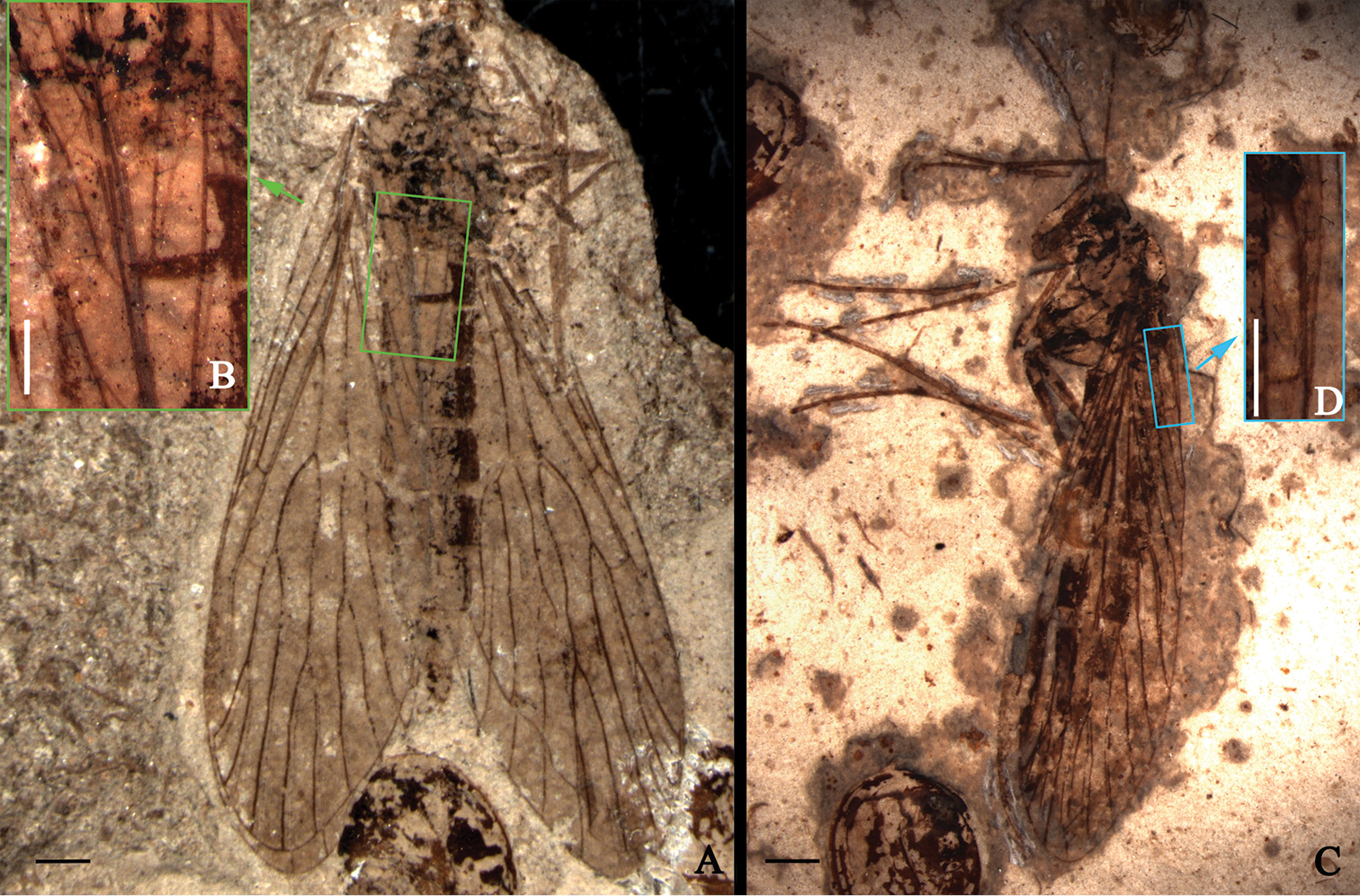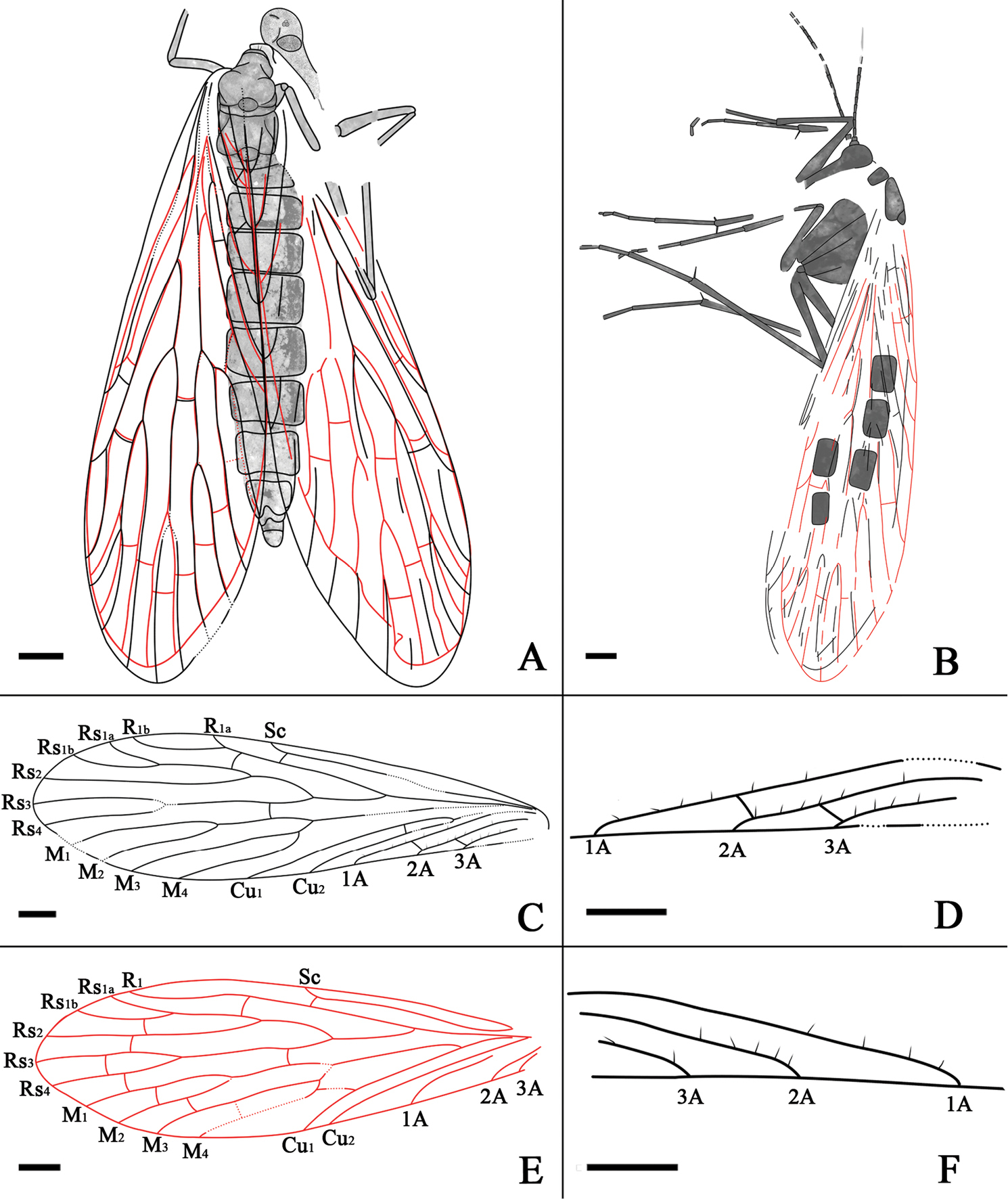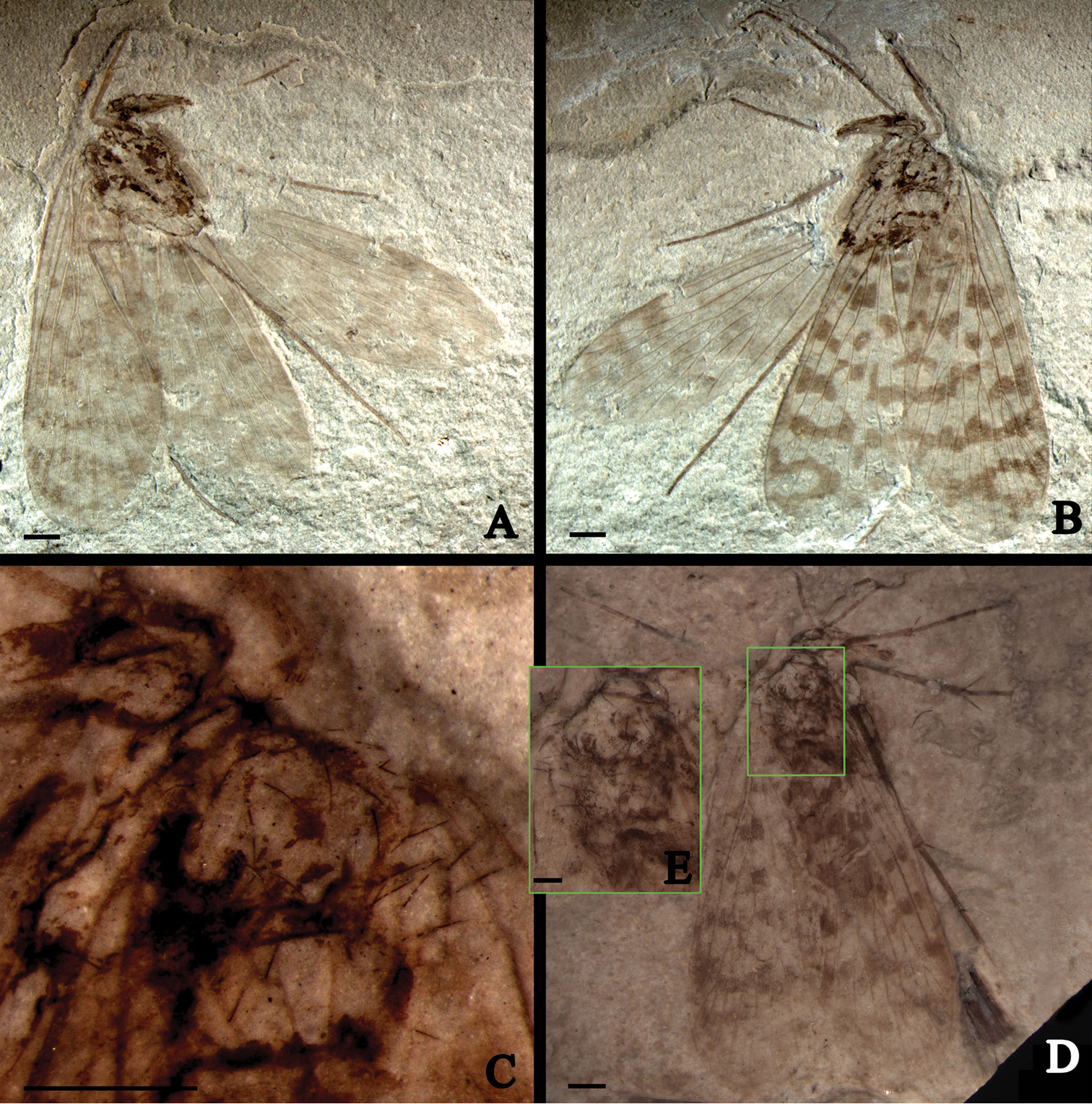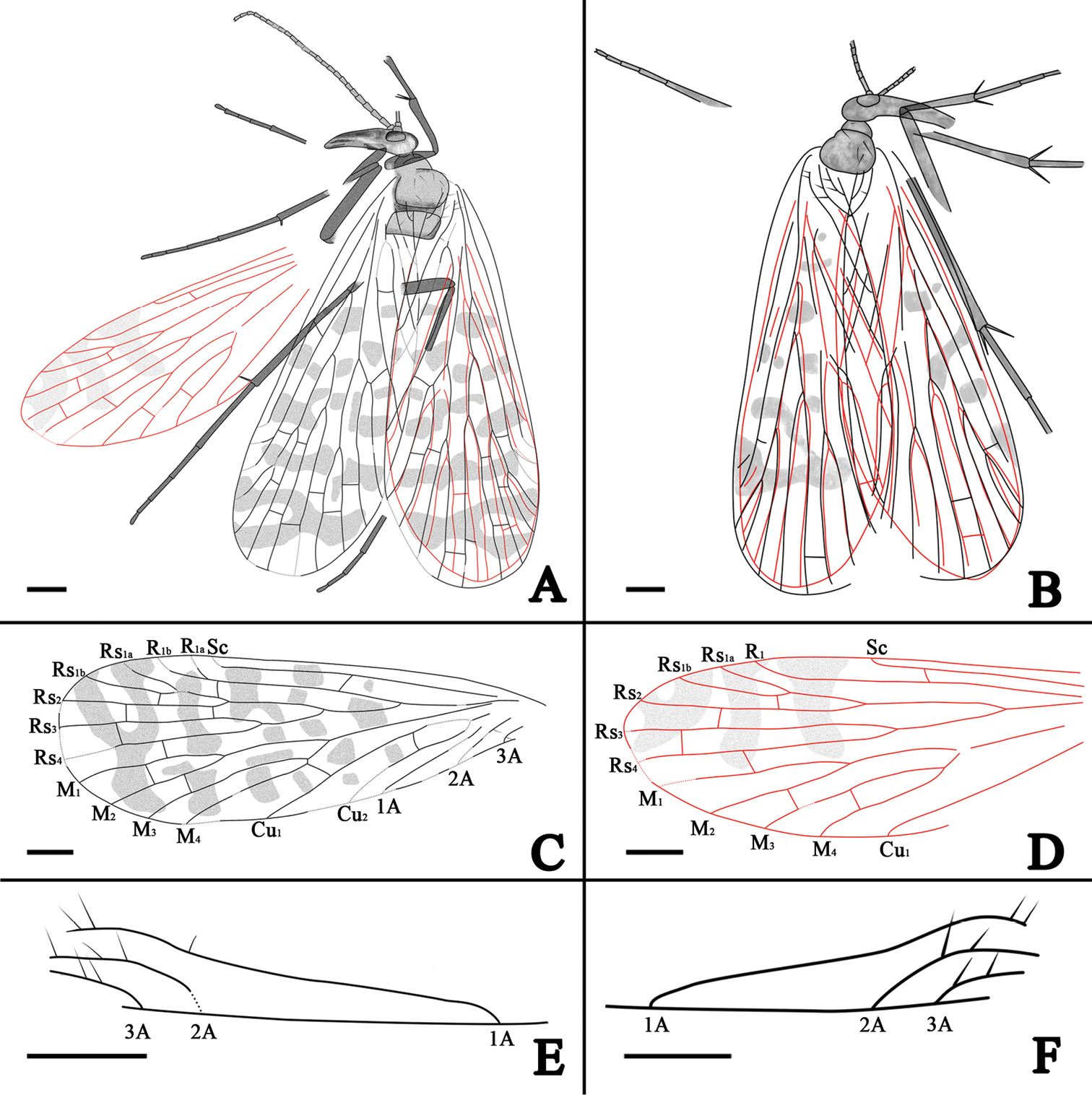






Citation: Ding H, Shih C, Bashkuev A, Zhao Y, Ren D (2014) The earliest fossil record of Panorpidae (Mecoptera) from the Middle Jurassic of China. ZooKeys 431: 79–92. doi: 10.3897/zookeys.431.7561
The early history of Panorpidae (Mecoptera) is poorly known due to sparse fossil records. Up to date, only nine fossil species have been described, all from the Paleogene, except the Early Cretaceous Solusipanorpa gibbidorsa Lin, 1980. However, we suggest S. gibbidorsa is too incompletely preserved to permit even family classification. A new genus with two new species, Jurassipanorpa impunctata gen. et sp. n. and Jurassipanorpa sticta sp. n., are described based on four well-preserved specimens from the late Middle Jurassic Jiulongshan Formation of Daohugou, Inner Mongolia, China. These two new species are the earliest fossil records of Panorpidae. The new genus is erected based on a combination of forewing characters: both R1 and Rs1 with two branches, 1A reaching posterior margin of wing distad of the forking of Rs from R1, and no crossveins or only one crossvein between veins of 1A and 2A. In all four specimens, long and robust setae ranging from 0.09 to 0.38 mm in length and pointing anteriorly, are present on anal veins of forewings. The function of these setae is enigmatic.
Jurassipanorpa, new genus, new species, new species, Jiulongshan Formation, Daohugou
Mecoptera is a small order of insects, comprising about 600 extant species assigned to nine families (
Fossil records of the Panorpidae are fairly rare. Up to date, only three genera have been described in this family and two of them are fossil-only genera: Solusipanorpa Lin, 1980 with one species from the Early Cretaceous of China (
Recently we collected four well-preserved fossils, which we attribute to Panorpidae, from the Jiulongshan Formation at Daohugou, Ningcheng County, Inner Mongolia, China. The Jiulongshan Formation is dated as the late Middle Jurassic, ca. 165 Ma (
This study is based on four fossil specimens collected from the late Middle Jurassic Jiulongshan Formation at Daohugou Village of Ningcheng County in Inner Mongolia, China. All type specimens are housed in the fossil insect collection of the Key Laboratory of Insect Evolution & Environmental Changes, College of Life Sciences, Capital Normal University, Beijing, China (CNUB; Dong Ren, Curator).
The specimens were examined and photographed using a Leica MZ12.5 dissecting microscope with a Leica DFC 500 digital camera and illustrated with the aid of a drawing tube attachment. The line drawings were drawn by Adobe Photoshop CS5. We use the venational nomenclature of
The generic name is a combination of Jurassic, highlighting the age of these fossil panorpids, and Panorpa, the type genus of Panorpidae. Gender feminine.
Jurassipanorpa impunctata Ding, Shih & Ren, sp. n.
Jurassipanorpa sticta Ding, Shih & Ren sp. n.
In forewing, Sc reaching the anterior margin near or beyond the middle of the wing; both R1 and Rs1 with two branches; 1A reaching posterior margin distad of the forking of Rs from R1; 3 anal veins present; one crossvein between Cu1 and Cu2 and between 1A and 2A respectively.
We assigned this genus to Panorpidae mainly based on the following characters: (1) head capsule with prolonged downward mouthparts; (2) slender wings and forewing slightly larger than hind wing with similar veins; (3) forewing Rs with five branches; (4) forewing M with four branches; (5) forewing Cu1 not fused with M basally, one crossvein between M4 and Cu1; and (6) hind wing Rs with five and M with four branches as those of forewing.
http://zoobank.org/021EE774-F1FC-4C91-A91F-7E39A5B82809
From the Latin impunctata, meaning no spots, referring to the fact that no spots and fasciae on all wings.
CNU-MEC-NN-2013006, a well-preserved female specimen with body and wings, but legs poorly preserved.
CNU-MEC-NN-2013012 P/C, sex unknown, with well-preserved legs, but four wings overlapping almost entirely and abdomen partially preserved.
Jiulongshan Formation, late Middle Jurassic; Daohugou Village, Ningcheng County, Inner Mongolia, China.
On both fore- and hind wings, Rs1+2 shorter than Rs1a+1b, Rs1+2 shorter than Rs3+4, Rs and M forking at the same level and no spots or fasciae.
Mainly based on Holotype, unless indicated as paratype. A well-preserved female adult fossil. Body 12 mm long. Forewing and hind wing overlapping almost entirely, but most of veins discernible. Thorax and abdomen preserved, but head poorly preserved. Legs poorly preserved, with only few fragments (Figs 1A, 2A, 2C–F).
Head: Head capsule with downward extended mouthparts; compound eyes large and oval, three ocelli present (Figs 1A, 2A); Antennae filiform in paratype (Figs 1C, 2B).
Thorax: In dorsal view, 2.9 mm long, two setae on pronotum as preserved. Pronotum, mesonotum, metanotum clearly discernible. Meso- and metanotum about the same size; larger than pronotum.
Abdomen: In dorsal view, 9 mm long, tapering apically, with eleven visible segments; segments IX-XI more slender and shorter than segments II-VI. Cerci not preserved. Sterna visible in segments II-VI.
Legs: Densely covered with short setae, two long tibial spurs preserved in a mid leg, one tibial spur preserved in a fore leg and two hind legs in paratype (Figs 1C, 2B).
Wings: Venation similar to venation of Panorpa. Forewing (Figs 1A, 2A, B, C, D, F) 14 mm long with a maximal width of 4 mm, longer than the abdomen; Sc terminating at anterior margin near the middle of the wing; one distally located crossvein between Sc and R1; R1 long, branching and curving around pterostigma; one crossvein present between R1 and Rs1; Rs with five branches; Rs1 forking into Rs1a and Rs1b; Rs1 and Rs3+4 forking nearly at the same level; Rs1+2 forking proximad of Rs3+4 forking; one crossvein between Rs3+4 and M1+2; Rs and M forking at the same level; M with four branches; M3+4 shorter than M1+2; Cu1 not fusing with M basally; one crossvein present between Cu1 and Cu2; 1A long, reaching posterior wing margin beyond the forking of Rs from R1; one crossvein between 1A and 2A; 2A and 3A long, one crossvein between 2A and 3A; long and robust setae ranging from 0.09 to 0.17 mm in length, present on veins 1A, 2A and 3A (Figs 1B, D, 2D, F). Hind wing (Figs 1A, 2A, E), 12.3 mm long with a maximal width of 3.9 mm, smaller than forewing distinctly, of similar shape and veins; Sc short, reaching anterior wing margin before one-half wing length; one crossvein present between Sc and R1; R1 without forking; Rs with five branches; Rs and M forking at almost the same level; one crossvein present between R1 and Rs1; Rs1 forking into Rs1a and Rs1b; one crossvein between Rs1b and Rs2; Rs2 without forking; one crossvein between Rs2 and Rs3; Rs1+2 forking proximad of Rs3+4 forking; one crossvein between Rs3 and Rs4; M1+2 forking proximad of Rs3+4 forking; one crossvein between Rs3+4 and M1+2 and one crossvein between Rs4 and M1; M with four branches; one crossvein between M1 and M2; M3+4 shorter than M1+2; one crossvein between M2 and M3 and between M3 and M4 respectively; Cu1 coalesced with M basally; one crossvein between M4 and Cu1; no crossveins between anal veins.
Jurassipanorpa impunctata gen. et sp. n., holotype, CNU-MEC-NN-2013006; paratype, CNU-MEC-NN-2013012 P/C. photos. A holotype B setae on forewings, under alcohol, outlined at rectangular frame in A; C paratype, under alcohol D setae on forewings, under alcohol, outlined at rectangular frame in C. Scale bars: 1 mm in A; 0.5 mm in B, C; 2 mm in C.
Jurassipanorpa impunctata gen. et sp. n. line drawings. A holotype B paratype C left forewing of the holotype D anal part of left forewing highlighting setae of the holotype E left hind wing of the holotype, crossvein between M3 and M4 is based on the right hind wing F right forewing highlighting setae of the holotype. Scale bars: 1 mm in A–F.
http://zoobank.org/73034C76-F459-48E5-A12C-EA1989478855
From the Greek stiktos, meaning spotted, referring to various spots and fasciae on wings.
CNU-MEC-NN-2013007 P/C, part and counterpart, sex unknown, well- preserved fore- and hind wings, but abdomen indiscernible.
CNU-MEC-NN-2013011, sex unknown, anal part of forewings well- persevered.
Jiulongshan Formation, late Middle Jurassic; Daohugou Village, Ningcheng County, Inner Mongolia, China.
On both fore- and hind wings, Rs1+2 longer than Rs1a+1b and Rs1+2 longer than Rs3+4. Rs and M forking at the same level on forewing but Rs forking proximad of M forking on hind wing. All wings with scattered dark spots and fasciae.
Mainly based on Holotype, unless indicated as paratype. A well-preserved adult fossil, sex unknown. Right forewing and hind wing nearly overlapping entirely, but most veins discernible, left forewing and right wings partially overlapping, left hind wing well preserved (Figs 3A, B, 4A).
Head: Head capsule with prolonged downward mouthparts as modern panorpids. Compound eyes large and oval; ocelli untraceable; antennae filiform, with 25 segments as preserved.
Thorax: poorly preserved (Figs 3A–C, 4A), only prothorax and part mesothorax recognizable. Few setae on tergum.
Legs: Densely covered with short setae; one mid leg not preserved; coxae and trochanters of all legs not preserved; femur and tibia long; two long tibial spurs present on a fore leg, one tibial spur present on a hind leg and one of them incomplete on a mid leg.
Abdomen: Indiscernible.
Wings: Forewing, 11 mm long with a maximum width of 3.9 mm, with scattered dark spots and fasciae (Figs 3A–C, 4A, C, E) with a different pattern from those of extant Panorpidae. Sc long, reaching anterior wing margin beyond one-half of wing length; one crossvein between Sc and R1 located nearly of mid-length of Sc; R1 long with two branches; one crossvein between R1 and Rs1; Rs with five branches, originating from R1 nearly basal 1/3 of forewing length; Rs1 forking into Rs1a and Rs1b; one crossvein between Rs1b and Rs2; two crossveins between Rs2 and Rs3; Rs1+2 forking distad to Rs3+4 forking; one crossvein between Rs3 and Rs4; Rs and M forking at almost the same level; one crossvein between Rs4 and M1; M with four branches; one crossvein between M1 and M2; M3+4 shorter than M1+2; one crossvein between M2 and M3; Cu1 not fusing with M basally, but joining M4 by a oblique crossvein; Cu1 fusing with Cu2 basally and one crossvein between Cu1 and Cu2; 1A long, reaching posterior wing margin distad to the origination of Rs from R1; 2A and 3A short; long and robust setae ranging from 0.15 to 0.38 mm in length, present on veins 1A, 2A and 3A of holotype and paratype (Fig. 4E, F). Left hind wing extended, right hind wing covered by the right forewing, incomplete; hind wing 9 mm long with a maximal width of 3.2 mm, smaller than forewing distinctly, of similar shape and veins (Figs 3A, B, 4A, D); but fasciae much reduced. Sc short, reaching anterior wing margin beyond one-half of wing length; one crossvein between Sc and R1; R1 long without forking; Rs with five branches; Rs1 forking into Rs1a and Rs1b; one crossvein between Rs1b and Rs2; Rs1 shorter than Rs1+2; one crossvein between Rs2 and Rs3; Rs1+2 forking distad to Rs3+4 forking; one crossvein between Rs3 and Rs4; M furcating distad to the Rs forking; one crossvein between Rs4 and M1; M with four branches; one crossvein between M2 and M3; M3+4 shorter than M1+2; one crossvein between M3 and M4; Cu1 coalesced with M basally; no crossveins present between M and Cu1; anal veins not discernible on hind wing due to poor preservation.
Jurassipanorpa sticta sp. n. is differentiated from Jurassipanorpa impunctata gen. et sp. n. by the following characters: (1) Jurassipanorpa sticta with various spots and fasciae (vs. Jurassipanorpa impunctata without spots and fasciae); (2) Rs1+2 longer than Rs1a+1b (vs. Rs1+2 shorter than Rs1a+1b); (3) Rs1+2 longer than Rs3+4 (vs. Rs1+2 shorter than Rs3+4) (4) Rs and M forking at the same level on forewing, but Rs furcating proximad of M forking on hind wing (vs. Rs and M forking at the same level on both fore- and hind wing).
Jurassipanorpa sticta sp. n., holotype, CNU-MEC-NN-2013007 P/C; paratype, CNU-MEC-NN-2013011. photos. A part of the holotype B counterpart of the holotype C anal part of forewings of the holotype, under alcohol D paratype, under alcohol E setae on forewings, under alcohol, outlined at rectangular frame in D. Scale bars: 1 mm in A–D, 0.5 mm in E.
Jurassipanorpa sticta sp. n. line drawings. A holotype B paratype C left forewing of the holotype D left hind wing of the holotype E anal part of right forewing highlighting setae of the holotype F left forewing highlighting setae of the paratype. Scale bars: 1 mm in A–F.
In the vast insect fossil collection at the Capital Normal University (> 250, 000 fossil insect specimens), we have collected only four panorpid fossils so far from the Daohugou locality. Informal survey of the Mecoptera collection indicates that specimens of Nannochoristidae are abundant, followed by many specimens of Orthophlebiidae, Bittacidae, and Cimbrophlebiidae, then, low numbers of Choristopsychidae, Mesopsychidae, Aneuretopsychidae, Pseudopolycentropodidae, and Eomeropidae, while very rare for Panorpidae. It is interesting to note that the rarity of Panorpidae during the Middle Jurassic of northeastern China is in contrast to their dominance in the Recent world fauna of Mecoptera (about 66% of all extant species).
Described fossil records of the Panorpidae in Mesozoic are extremely rare. Up to now, only one species, Solusipanorpa gibbidorsa Lin, 1980, has been described. However, we consider the holotype of Solusipanorpa gibbidorsa as not sufficiently preserved to be attributed to Panorpidae nor to any other family, and regard Solusipanorpa gibbidorsa as Mecoptera incertae sedis. Eight species in two genera: Panorpa Linnaeus, 1758, and Baltipanorpa Krzemiński, 2012, have been reported from the Eocene and Oligocene, however Carpenter stated that “Panorpa rigida Scudder, from the Florissant shales, is too incompletely preserved to permit even family classification.” and “Panorpa arctiiformis Cockerell, also from the Florissant shales, is undoubtedly a member of the family Panorpidae, but I have not seen the type specimen and there is nothing in the description to indicate its affinities.” (
Based on studies of these two new species and documented species of other representative panorpids, we compare and summarize six key forewing characters in Table 1. A combination of the following characters enables us to distinguish the new genus from all other described genera of Panorpidae: (1) R1 with two branches in forewing – same as Baltipanorpa, Furcatopanorpa and a rare few species of Panorpa, but different from all other genera with only one branch; (2) Rs1 with two branches of Rs1a and Rs1b – different from Sinopanorpa with 3 branches; (3) 1A reaching posterior margin distad of the forking of Rs from R1 in forewing – same as Panorpa, Sinopanorpa, Furcatopanorpa, Dicerapanorpa, and Baltipanorpa, in contrast to significantly shortened 1A in Neopanorpa and Leptopanorpa; (4) no crossveins or only one crossvein between 1A and 2A on forewing – different from almost all other genera of Panorpidae, Neopanorpa and Leptopanorpa (one crossvein), Panorpa (one or two crossveins), Sinopanorpa, and Dicerapanorpa (two crossveins), Baltipanorpa and Furcatopanorpa (three crossveins); (
We found that the wing venation of this family is comparatively stable, that is, Sc not forking, Rs2, Rs3, Rs4 without forking, and M with 4 branches. However, Rs1 is rather variable, typically, Rs1 has two branches, but, some with three branches such as Sinopanorpa, while three Mexican extant species Panorpa dividilacinia, P. mixteca, P. umbricola have only a single Rs1 (
Most panorpids have M4 bending basally in forewings, that is, M3 is a straight branch while M4 is derived from M3 with a basal bending. However, this character is not obvious for some extant panorpids, such as Panorpa wangwushana Huang, Hua and Shen, 2004 (
All four specimens of Jurassipanorpa impunctata gen. et sp. n. (Figs 1B, D, 2D, F) and Jurassipanorpa sticta sp. n. (Figs 3C, E, 4E, F) have remarkable long and robust setae on anal veins of the forewings that are not known for any other described fossil or extant panorpid species. Unlike these of Jurassipanorpa gen. n., setae on veins of extant species of Panorpidae as well as of Mesozoic Orthophlebiidae are usually more dense, shorter and decumbent unidirectionally and look similar to microtrichia on the wing membrane (
Comparison of fossil and extant genera of Panorpidae with six key forewing characters.
| Genus | Species | Position of Sc reaching anterior margin | Branches of R1 | Branches of Rs1 | position of 1A reaching the posterior margin | number of crossveins between 1A and 2A | number of crossveins on forewing | Comments | |
|---|---|---|---|---|---|---|---|---|---|
| extant genera | Panorpa Linnaeus, 1758 | Panorpa communis L. 1758 | beyond the middle of wing | 1 (2 only in rare cases) | 2–3 | far beyond the forking of Rs from R1 | 2 | about 22 | |
| Neopanorpa Weele, 1909 | Neopanorpa appendiculata (Westwood, 1846) | beyond the middle of wing | 1 | 2 | not beyond the forking of Rs from R1 | 1 | about 23 | ||
| Leptopanorpa MacLachlan, 1875 | Leptopanorpa ritsemae MacLachlan, 1875 | beyond the middle of wing | 1 | 2 | at same level as the forking of Rs from R1 | 1 | about 27 | wings are slender and much narrower basally | |
| Sinopanorp a Cai and Hua, 2008 | Sinopanorp tincta (Navas, 1931) | beyond the middle of wing | 1 | 3 | far beyond the forking of Rs from R1 | 2 | about 22 | ||
| Furcatopanorpa Ma & Hua, 2011 | Furcatopanorpa longihypovalva (Hua & Cai, 2009) | near the middle of wing | 2 (fore- and hind wings) | 2 | far beyond the forking of Rs from R1 | 3 | about 26 | wings held roof-like over the abdomen at rest. | |
| Dicerapanorpa Zhong & Hua, 2013 | Dicerapanorpa magna (Chou, 1981) | beyond the middle of wing | 1 (but 2 in hind wings of some cases) | 2 | far beyond the forking of Rs from R1 | 2 | about 26 | ||
| fossil genera | Baltipanorpa Krzemiński, 2012, Eocene | Baltipanorpa damzeni Krzemiński, 2012 | before the middle of wing | 2 | 2 | at same level as the forking of Rs from R1 | 3 | about 26 | |
| Jurassipanorpa gen. n., Middle Jurassic | Jurassipanorpa impunctata gen. et sp. n. | at the middle of wing | 2 | 2 | far beyond the forking of Rs from R1 | 1 | 6 | no spots and fasciae | |
| Jurassipanorpa sticta sp. n. | beyond the middle of wing | 2 | 2 | far beyond the forking of Rs from R1 | 0 | 11 | spots and fasciae much different from extant Panorpidae |
We appreciate Dr. Taiping Gao, Dr. Qiang Yang, Chen Wang, Mei Wang, Qi Wang, Yan Zhu, Longfeng Li, Xiao Qiao, Xiaoguang Yang and Chaofan Shi in the Key Lab of Capital Normal University for their valuable comments and fruitful suggestion to the first author. This research was supported by the National Basic Research Program of China (973 Program; 2012CB821906), the National Natural Science Foundation of China (No. 31230065, 41272006), Great Wall Scholar and KEY project of the Beijing Municipal Commission of Education (KZ201310028033), Program for Changjiang Scholars and Innovative Research Team in University (IRT13081).



